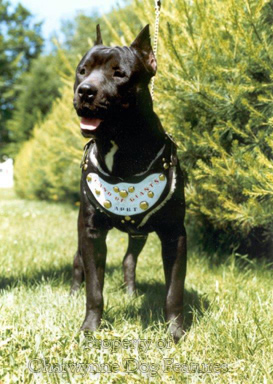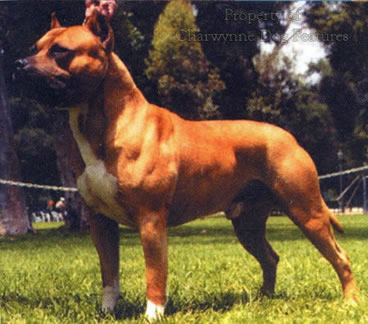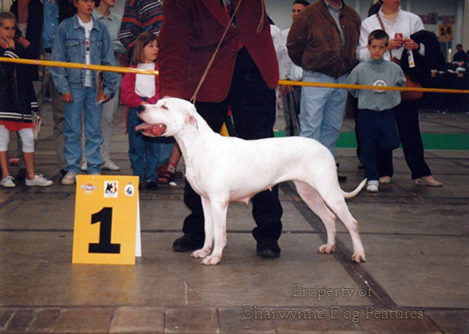190. A Shabby Dog Story- the DDA
A SHABBY DOG STORY: THE DESTRUCTION OF DOGS ACT
by David Hancock
 Once upon a time, in a land too close for comfort, there were half a dozen incidents in which domestic dogs savagely attacked human beings over a two year period. Utterly predictably, the popular press screamed for government action. Equally predictably, the government reacted - as all bureaucrat-led administrations do in such circumstances - by passing legislation, against "dangerous dogs". These savage attacks by dogs on humans were perpetrated by Dobermanns, Rottweilers, German shepherd dogs and pit bull terriers. The first three of these breeds are recognised by the Kennel Club and mainly owned by a vocal middle class. Pit bull terriers are not recognised as a breed by the KC and are owned almost exclusively by a less articulate working class. Guess which breed got banned! Over a thousand well-behaved pit bull terriers have been destroyed since this hastily-conceived ill-considered legislation was passed.
Once upon a time, in a land too close for comfort, there were half a dozen incidents in which domestic dogs savagely attacked human beings over a two year period. Utterly predictably, the popular press screamed for government action. Equally predictably, the government reacted - as all bureaucrat-led administrations do in such circumstances - by passing legislation, against "dangerous dogs". These savage attacks by dogs on humans were perpetrated by Dobermanns, Rottweilers, German shepherd dogs and pit bull terriers. The first three of these breeds are recognised by the Kennel Club and mainly owned by a vocal middle class. Pit bull terriers are not recognised as a breed by the KC and are owned almost exclusively by a less articulate working class. Guess which breed got banned! Over a thousand well-behaved pit bull terriers have been destroyed since this hastily-conceived ill-considered legislation was passed.
No rational dog owner wants to possess a dog that is dangerous to innocent human beings; any dog of any breed which wantonly attacks people must be humanely destroyed without delay. All right-minded dog owners are only too anxious to see the good name of dog protected and rogue dogs removed. Most dog owners are aware that rogue dogs are either created by bad owners or bad blood. Any spirited dog can be made bad-tempered by repeated abuse. But far more dangerous are bad genes; psychopathic dogs are much more likely to come from psychopathic parents and a psychopathic litter.
If a dog which has been persistently abused turns savage however, it is, under the Dangerous Dogs Act of 1991, the dog which is punished more severely than the abuser. Is that just? And if a dog goes beserk, wouldn't it be wiser to look at its parents, brothers and sisters too? But this does not happen; the act decrees that some breeds are dangerous and others are not. Dangerous dogs are identified by breed rather than deed. The original act even goes so far as to name specific breeds of dog "bred for fighting" and then proceeds to proscribe three breeds from overseas not bred for fighting yet overlooks two breeds of dog purpose-bred for centuries to fight: the Staffordshire bull terrier and the Chinese Shar Pei. That doesn't sound particularly fair to me.
The three foreign breeds originally banned under this act and its concomitant import restrictions (now relaxed) are the South American Dogo Argentino and Fila Brasiliera and the Tosa (still banned) from Japan. Cynologists would describe them as hunting mastiffs, rather like the Great Dane and the Broholmer. The mastiff group was prized as big game hunting dogs because of their size, strength and instinctive ability to seize and hold their prey. In this way, primitive man obtained meat by hunting with such dogs before the invention of firearms. Such dogs do not nip or bite, they seize their quarry and "detain" it. Down the centuries, dogs from this canine family have been portrayed in the company of children and smaller toy dogs because of their reputation for magnanimity and forebearance. Bad tempered mastiffs were bred out long ago. I can find no recorded incident in which a dog from one of these three banned breeds committed a savage unprovoked attack on a human being.
So how were these three foreign breeds so unjustly identified? The act permits the Secretary of State to consult a "body concerned with breeds of dog". In the UK that body can only be the Kennel Club. But the KC is principally concerned with the appearance of pedigree dogs and rates temperament in dogs way down on its list of priorities. When authorising breed standards, the written blueprint for each breed, the KC dismisses temperament in a few words but over one hundred words can be used to describe a dog's head and more than forty for a tail. The three foreign breeds banned are not even recognised by the KC; how could they possibly have substantive evidence of their behaviour? They are clearly not particularly interested in the behaviour of the breeds which they do recognise.
But of course the financial base of the Kennel Club lies in obtaining registration fees. Popular breeds such as the Dobermann, the Rottweiler and the German shepherd dog probably bring in around £300,000 each year to the KC receipts. What a loss of revenue if a notorious breed like the Rottweiler were to be banned! Yet this breed name itself has now come into contemporary use to denote viciousness, rightly or wrongly. But the act is intent on banning breeds judged guilty, that is why so many well-behaved pit bull terriers have lost their lives. And this slaughter of the innocent has occurred at a time when two breeds of dog intentionally "bred for fighting", as the act puts it, are recognised and promoted by the KC, the body advising the Minister, and not banned as breeds by the act which defines and then proscribes such dogs.
Both the Staffordshire bull terrier and the Chinese fighting dog, the Shar Pei, were developed as breeds to fight other dogs. In their respective countries of origin both sadly still do. I have no wish to see either breed (or indeed any breed) banned. But the wording of the act covers such dogs and under that wording they should logically be banned. The act is not respecting its own provisions - why should any member of the dog-owning public respect such a law?
It is naive to think that by passing a hastily cobbled together piece of legislation we can at a stroke prevent bone-headed misguided morons, whether pathetic skinheads or rather more deadly drug barons, from favouring a certain type of dog to project their image or obstruct the police. If the pit bull terrier is banned, then a Rottweiler cross will be utilised. And since you can't get a black and tan pit bull terrier any positive identification could be contested. If that "type" is banned, then another type will be patronised: a chow crossed with an Irish terrier or a Japanese Akita with a Shar Pei. All four breeds have been used for dog fighting in the past.
In Afghanistan, Nepal and Tibet there are huge herding dogs long famed for their ill-temper, savage disposition and, especially in Afghanistan, for their feats in the dog fighting ring. Travellers in Tibet over the last century have recorded again and again the savage nature of many of these dogs. This group of dogs is represented in the Western world by the Tibetan mastiff, a breed recognised by the KC in the UK. But the Tibetan mastiffs being bred in Britain, Holland and the USA are well-behaved, good-tempered and nice-natured. There is never any sense in banning a breed and to do so is to introduce a canine form of ethnic cleansing.
A cynic might be forgiven for summarising the Dangerous Dogs Act of 1991 as one: aimed at the weakest lobby, constructed by a body with considerable financial interest in its application and one knowingly permitting the continued breeding from dogs which produce savage offspring, whilst sending innocent dogs for destruction, after their identification by individuals who wouldn't know a Dogo Argentino from a Drentse Patrijshond. We should be ashamed at accepting such mistaken legislation so meekly, or does political correctness afflict dogmen too? It's a pity there isn't a Race Relations Act for dogs. There certainly isn't any justice for dogs in the Dangerous Dogs Act.